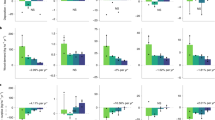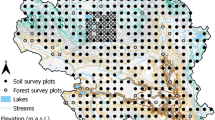Abstract
Because of global warming, the frequency and severity of droughts are expected to increase, which will have an impact on forest ecosystem health worldwide1. Although the impact of drought on tree growth and mortality is being increasingly documented2–4, very little is known about the impact on nutrient cycling in forest ecosystems. Here, based on long-term monitoring data, we report nutrient fluxes in a boreal forest before, during and following a severe drought in July 2012. During and shortly after the drought, we observed high throughfall (rain collected below the canopy) concentrations of nutrient base cations (potassium, calcium and magnesium), chlorine, phosphorus and dissolved organic carbon (DOC), differing by one to two orders of magnitude relative to the long-term normal, and resulting in important canopy losses. The high throughfall fluxes had repercussions in the soil solution at a depth of 30 cm, leading to high DOC, chlorine and potassium concentrations. The net potassium losses (atmospheric deposition minus leaching losses) following the drought were especially important, being the equivalent of nearly 20 years of net losses under ‘normal’ conditions. Our data show that droughts have unexpected impacts on nutrient cycling through impacts on tree canopy and soils and may lead to important episodes of potassium losses from boreal forest ecosystems. The potassium losses associated with drought will add to those originating from tree harvesting and from forest fires and insect outbreaks5–7 (with the last two being expected to increase in the future as a result of climate change), and may contribute to reduced potassium availability in boreal forests in a warming world.
This is a preview of subscription content, access via your institution
Access options
Subscribe to this journal
Receive 12 digital issues and online access to articles
$119.00 per year
only $9.92 per issue
Buy this article
- Purchase on Springer Link
- Instant access to full article PDF
Prices may be subject to local taxes which are calculated during checkout



Similar content being viewed by others
References
IPCC Climate Change 2013: The Physical Science Basis (eds Stocker, T. F. et al.) (Cambridge Univ. Press, 2013).
Van Mantgem, P. J. et al. Widespread increase of tree mortality rates in the western United States. Science 323, 521–524 (2009).
Peng, C. et al. A drought-induced pervasive increase in tree mortality across Canada's boreal forests. Nat. Clim. Change 1, 467–471 (2011).
McDowell, N. G. et al. Multi-scale predictions of massive conifer mortality due to chronic temperature rise. Nat. Clim. Change 6, 295–300 (2016).
Lamontagne, S., Carignan, R., D'Arcy, P., Prairie, Y. T. & Paré, D. Element export in runoff from eastern Canadian boreal shield drainage basins following forest harvesting and wildfires. Can. J. Fish. Aquat. Sci. 57, 118–128 (2000).
Frost, C. J. & Hunter, M. D. Insect canopy herbivory and frass deposition affect soil nutrient dynamics and export in oak mesocosms. Ecology 85, 3335–3347 (2004).
Houle, D., Duchesne, L. & Boutin, R. Effects of a spruce budworm outbreak on element export below the rooting zone: a case study for a balsam fir forest. Ann. For. Sci. 66, 707–707 (2009).
Meehl, G. A . & Tebaldi, C. More intense, more frequent, and longer lasting heat waves in the 21st century. Science 305, 994–997 (2004).
Jolly, W. et al. Climate-induced variations in global wildfire danger from 1979 to 2013. Nat. Commun. 6, 7537 (2015).
Seidl, R., Schelhaas, M. -J., Rammer, W. & Verkerk, P. Increasing forest disturbances in Europe and their impact on carbon storage. Nat. Clim. Change 4, 806–810 (2014).
Griffin, J. M., Turner, M. G. & Simard, M. Nitrogen cycling following mountain pine beetle disturbance in lodgepole pine forests of Greater Yellowstone. For. Ecol. Manage. 261, 1077–1089 (2011).
Attiwill, P. M. & Adams, M. A. Nutrient cycling in forests. New Phytol. 124, 561–582 (1993).
Gutschick, V. P. & BassiriRad, H. Extreme events as shaping physiology, ecology, and evolution of plants: toward a unified definition and evaluation of their consequences. New Phytol. 160, 21–42 (2003).
Fernàndez-Martinez, M. et al. Nutrient availability as the key regulator of global forest carbon balance. Nat. Clim. Change 4, 471–476 (2014).
Sardans, J., Penuelas, J. & Ogaya, R. Drought's impact on Ca, Fe, Mg, Mo and S concentration and accumulation patterns in the plants and soil of a Mediterranean evergreen Quercux ilex forest. Biogeochemistry 87, 49–69 (2008).
Sardans, J. & Penuelas, J. Drought decreases soil enzyme activity in a Mediterranean Quercux ilex L. forest. Soil Biol. Biochem. 37, 455–461 (2005).
Gilgen, A. K. & Feller, U. Effects of drought and subsequent rewatering on Rumex obtusifolius leaves of different ages: reversible and irreversible damages. J. Plant Interact. 9, 37–41 (2013).
Catling, P. M. Impact of the 2012 drought on woody vegetation invading alvar grasslands in the Burnt Lands Alvar, eastern Ontario. Can. Field Nat. 128, 243–249 (2014).
Bai, X. et al. A record-breaking low ice cover over the Great Lakes during winter 2011/2012: combined effects of a strong positive NAO and La Niña. Clim. Dyn. 44, 1187–1213 (2015).
Duchesne, L. & Houle, D. Modelling day-to-day stem diameter variations and annual growth of balsam fir (Abies balsamea (L.) Mill.) from daily climatic variables. For. Ecol. Manage. 262, 863–872 (2011).
Houle, D., Ouimet, R., Paquin, R. & Laflamme, J.-G. Interactions of atmospheric deposition with a mixed hardwood and a coniferous forest canopy at the Lake Clair Watershed (Duchesnay, Quebec). Can. J. For. Res. 29, 1944–1957 (1999).
Wei, J. et al. Effects of external potassium (K) supply on drought tolerances of two contrasting winter wheat cultivars. PLoS ONE 8, 1–11 (2013).
Penuelas, J., Rico, L., Ogaya, R., Jump, A. S. & Terradas, J. Summer season and long-term drought increase the richness of bacteria and fungi in the foliar phyllosphere of Quercus ilex in a mixed Mediterranean forest. Plant Biol. 14, 565–575 (2012).
Rico, L., Ogaya, R., Terradas, J. & Peñuelas, J. Community structures of N2-fixing bacteria associated with the phyllosphere of a holm oak forest and their response to drought. Plant Biol. 16, 586–593 (2014).
Duchesne, L., Ouimet, R., Camiré, C. & Houle, D. Seasonal nutrient transfers by foliar resorption, leaching, and litter fall in a northern hardwood forest at Lake Clair Watershed, Quebec, Canada. Can. J. For. Res. 31, 333–344 (2001).
Staelens, J., De Schrijver, A. & Verheyen, K. Seasonal variation in throughfall and stemflow chemistry beneath a European beech (Fagus sylvatica) tree in relation to canopy phenology. Can. J. For. Res. 37, 1359–1372 (2007).
Carnicer, J. et al. Widespread crown condition decline, food web disruption, and amplified tree mortality with increased climate change-type drought. Proc. Natl Acad. Sci. USA 108, 1474–1478 (2011).
Schulze, K., Borken, W. & Matzner, E. Dynamics of dissolved organic 14C in throughfall and soil solution of a Norway spruce forest. Biogeochemistry 106, 461–473 (2011).
Houle, D. et al. Soil weathering rates in 21 catchments of the Canadian shield. Hydrol. Earth Syst. Sci. 16, 685–697 (2012).
Draaijers, G. P. J. et al. The impact of canopy exchange on differences observed between atmospheric deposition and throughfall fluxes. Atmos. Environ. 31, 387–397 (1997).
Johnson-Maynard, J. L., Graham, R. C., Shouse, P. J. & Quideau, S. A. Base cation and silicon biogeochemistry under pine and scrub oak monocultures: implications for weathering rates. Geoderma 126, 353–365 (2005).
Sardans, J. & Peñuelas, J. Drought changes phosphorus and potassium accumulation patterns in an evergreen Mediterranean forest. Funct. Ecol. 21, 191–201 (2007).
Dijkstra, F. A., He, M., Johansen, M. P., Harrison, J. J. & Keitel, C. Plant and microbial uptake of nitrogen and phosphorus affected by drought using 15N and 32P tracers. Soil Biol. Biochem. 82, 135–142 (2015).
Sardans, J., Penuelas, J., Prieto, P. & Estiarte, M. Drought and warming induced changes in P and K concentration and accumulation in plant biomass and soil in a Mediterranean shrubland. Plant Soil 306, 261–271 (2008).
Baum, C., Leinweber, P. & Schlichting, A. Effects of chemical conditions in re-wetted peats temporal variation in microbial biomass and acid phosphatase activity within the growing season. Appl. Soil Ecol. 22, 167–174 (2003).
Duchesne, L. & Houle, D. Investigating the impact of nutrient cation removal through harvesting on the long term sustainability of the boreal forest. Ecol. Appl. 18, 1642–1651 (2008).
Ouimet, R. & Moore, J. D. Effects of fertilization and liming on tree growth, vitality and nutrient status in boreal balsam fir stands. For. Ecol. Manage. 345, 39–49 (2015).
Gauthier, S., Bernier, P., Kuuluvainen, T., Shvidenko, A. Z. & Schepaschenko, D. G. Boreal forest health and global change. Science 349, 819–822 (2015).
Sardans, J. & Peñuelas, J. Potassium: a neglected nutrient in global change. Glob. Ecol. Biogeogr. 24, 261–275 (2015).
Houle, D., Bouffard, A., Duchesne, L., Logan, T. & Harvey, R. Projections of future soil temperature and water content for three southern Quebec forested watersheds. J. Climate 25, 7690–7701 (2012).
McKenney, D. et al. Customized spatial climate models for North America. BAMS 92, 1611–1622 (2011).
Schiffler, R. Maximum Z scores and outliers. Am. Stat. 42, 79–80 (1998).
Grubbs, F. Sample criteria for testing outlying observations. Ann. Math. Stat. 21, 27–58 (1950).
Acknowledgements
This research was supported by the Ministère des Forêts, de la Faune et des Parcs du Québec (MFFP). We would like to thank J. Gagné, and M. St-Germain for field assistance, and the chemistry laboratory of the Direction de la recherche forestière (MFFP) for chemical analyses. We also thank T. Logan for providing Fig. 1.
Author information
Authors and Affiliations
Contributions
L.D. and D.H. designed and performed the experiment. D.H., G.L. and L.D. analysed the data. D.H. and G.L. wrote the manuscript and L.D. revised the manuscript.
Corresponding author
Ethics declarations
Competing interests
The authors declare no competing financial interests.
Supplementary information
Supplementary Information
Supplementary Figures 1–4, Supplementary Table 1. (PDF 752 kb)
Rights and permissions
About this article
Cite this article
Houle, D., Lajoie, G. & Duchesne, L. Major losses of nutrients following a severe drought in a boreal forest. Nature Plants 2, 16187 (2016). https://doi.org/10.1038/nplants.2016.187
Received:
Accepted:
Published:
DOI: https://doi.org/10.1038/nplants.2016.187
This article is cited by
-
Observational evidence of legacy effects of the 2018 drought on a mixed deciduous forest in Germany
Scientific Reports (2023)
-
Initiating the transition from open-canopy lichen woodland to productive forest by transplanting moss, results from a 10-year experiment
Plant and Soil (2023)
-
Low growth resilience to drought is related to future mortality risk in trees
Nature Communications (2020)
-
Interactions between predation and disturbances shape prey communities
Scientific Reports (2018)



